The TOZO OpenReal are the manufacturer’s second venture into the open-ear headphones market and, just like with the Open Buds, the developers opted to use the air conduction approach. I have tested another similar pair before, the OneOdio OpenRock Pro and the concept is pretty much the same.
| TOZO OpenReal | |
|---|---|
| TozoStore.com | Check Product |
| Amazon.com | Check Offer |
Instead of having the earbuds pushed into the ear canal, there is now a fairly large driver (16.2mm driver, same as on the OpenRock Pro) which points towards the inner ear and directs the sound towards it. So they’re much better for situational awareness when you’re in traffic (while riding a bike, for example) and no more inner ear canal irritation.
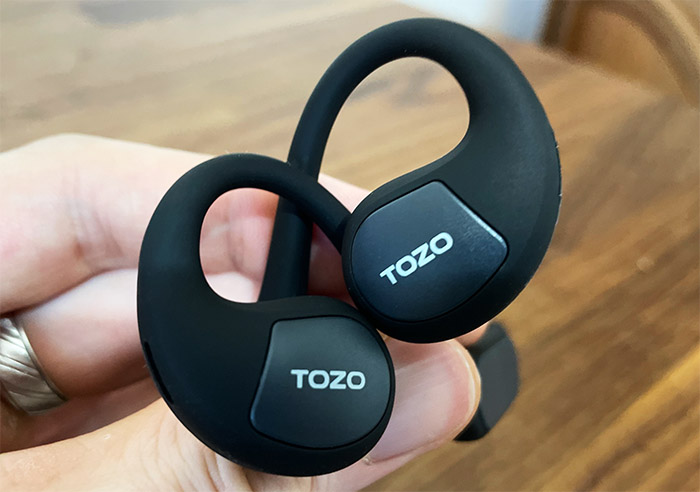
But, there are a few drawbacks that you need to be aware of. First, there most likely will be some sound bleed, especially at a higher volume and secondly, the bass may not be that great. I know that other brands using the same tech have been struggling to offer a good bass reproduction, but it wasn’t on the same level as when using regular TWS earbuds. Far from it actually.
Is the TOZO OpenReal more capable in this regard? Well, they do make a parallel to the bone-conduction technology which also struggles with bass reproduction, but they also do say that we should get clear sound with powerful bass, so I look forward to see them in action. Additionally, there’s an app which will hopefully allow some degree of sound customization, so without further ado, let’s put the TOZO OpenReal air conduction headphones to the test and see how they perform.
Build Quality and Design
The TOZO OpenReal headphones adopt what the manufacturer calls ‘airy wearing’ design and, if you’re familiar with the bone conduction headphones (like the Haylou PurFree BC01), it’s pretty much the same concept. The two ‘earbuds’ are inter-connected by a flexible band which goes around the head of the user, resting above the ears.
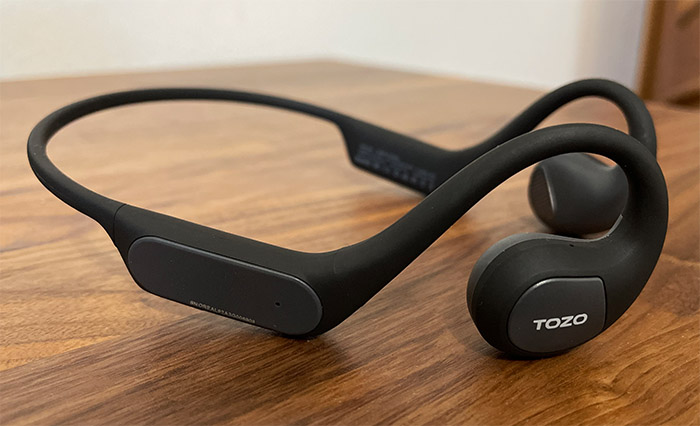
This way, the two speakers are perfectly aligned to the inner ear canal opening. The entire device is covered by a soft dark matte finish and it does have a rubbery texture with only very few places where there’s hard plastic. This soft rubber will ensure that there is no pressure on the head and the device is lightweight enough to not cause discomfort above the ear. But how long can you wear them before you will need a break?
I won’t deny that you will feel the TOZO OpenReal and depending on the type of activity you’re doing, you may need to take them off after about a couple of hours (most likely due to sweat if you’re working out). But, if you’re not wearing them while doing sports, then you should be able to handle them for way longer than that – the feeling is similar to wearing some thicker sunglasses. I have mentioned that there are a few parts made of solid plastic and there are a couple of them right before the headphones form the circular shape and the two speakers.
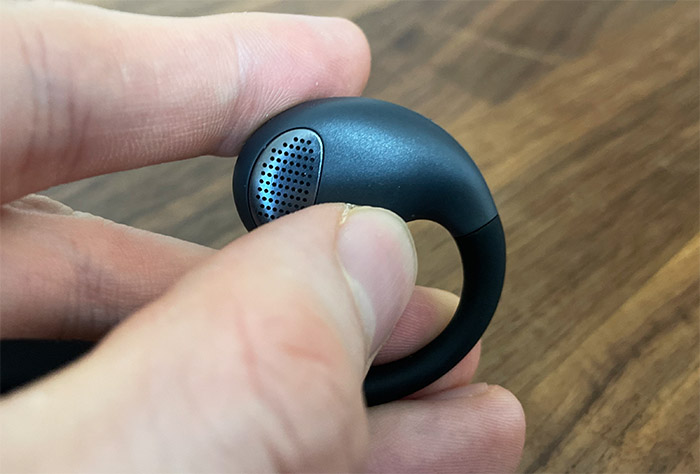
The left side section does not have any controls and I assume it’s there were the batteries are positioned, while on the right side, you will be able to find the physical buttons. There’s the volume up and down switch and the former also doubles as the Power button, as long as you long press it for four seconds. To move to the next track or to the previous one, you do need to long press the Plus/Minus button for two seconds. Next to these buttons, I noticed a couple of metallic pins.
Are these for charging? While the TWS earbuds are too small to have USB-C added to them, I saw that headphones which had a similar design to the TOZO OpenReal did indeed add a USB-C port for charging up the inner battery. But it seems that TOZO did not like the universal connector and preferred to go with a proprietary one. And this is really not the time when when we should consider adding even more e-waste in the environment, so this has been a massively uninspired decision.
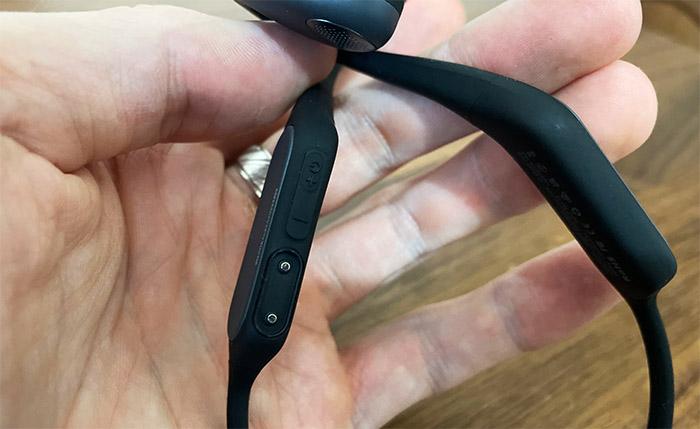
The two speakers are covered by a plastic grille and next to them, I could also see two fairly large microphones which have the role of limiting the impact of the environmental noise, putting the focus on the user’s voice. There is more because on the outer right section (the other side from where you see the speaker), there is a touch-sensitive spot where you can play and pause the track with a single tap.
This area can also be used for controlling a call – single tap for answering the call, triple tap to hang up and hold it to reject the call. There is also support for Siri – just tap on the touch-sensitive area for a couple of seconds to enable the voice assistant.
How rugged is the TOZO OpenReal?
The TOZO OpenReal headphones seem to be able to survive mechanical shocks due to that rubbery exterior and you can stretch the arms as far away as you want without damaging the device. Additionally, the TOZO OpenReal are IPX8-rated which means that they’re very close to be truly waterproof. Sweat won’t harm them, neither will rain or showers. So, while they may not look like it, the TOZO OpenReal are fairly rugged and will survive outdoor conditions.
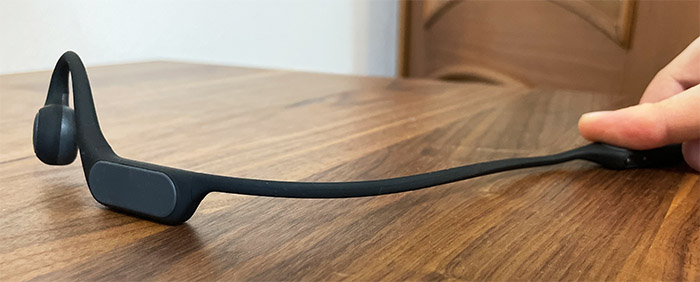
Internal Hardware and Connectivity
The manufacturer has disclosed that we’re dealing with 16.2mm drivers and that they also make use of the TOZO OrigX to amplify the bass, something that’s very much needed for this type of headphones. I have seen that even OneOdio developed a similar technology called TubeBass and it serves the same bass-amplifying purpose. The developers did not mention the exact chipset that they equipped the TOZO OpenReal with, but it’s most likely the same Qualcomm QCC3040 used by the OpenRock Pro.
As for the Bluetooth version, the headphones rely on the version 5.3 and I noticed that while the range doesn’t really differ between version Bluetooth 4 and 5 (with all the newer iterations) – it’s still about 30 feet – the battery life does seem to be improved on the newer versions. So I do expect the TOZO OpenReal to have an excellent battery life. Lastly, I do need to mention that the headphones support AAC/SBC which are decent codecs, but not really built for higher-quality type of audio.
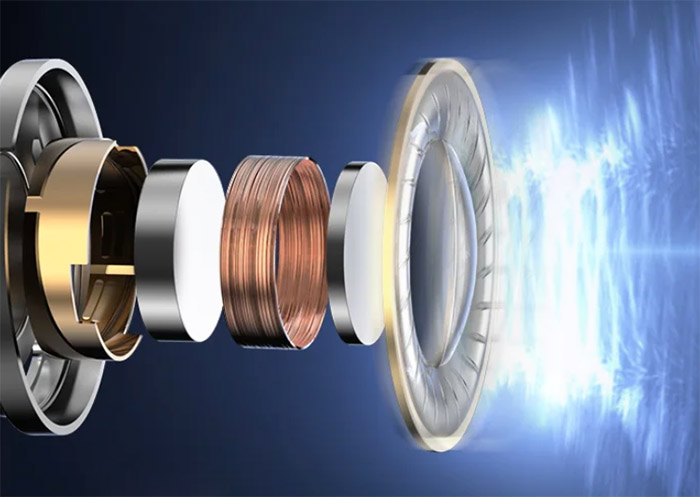
Also, there doesn’t seem to be support for Bluetooth Multipoint and I guess it makes sense at this price point (rarely do we see an unicorn such as the Haylou S35).
The Sound Quality
Before listening to some songs, let’s first understand what air conduction headphones actually do. While the bone conduction headphones vibrates through your bones, reaching the inner ear, therefore being perfect for people that are hard of hearing, the air conduction relies on actual speakers to blast the sound to a certain direction. And the TOZO OpenReal is essentially built around this directional ability to focus the sound at a specific point with as little sound bleed as possible.
I have listened to some songs and any passerby will hear that something is being played in my ears, and it will become fairly clear if I increase the volume. But it’s not really a big difference between a pair of open-ear headphones, such as the OneOdio Monitor 80. Let’s say about 10 percent more with the TOZO OpenReal.
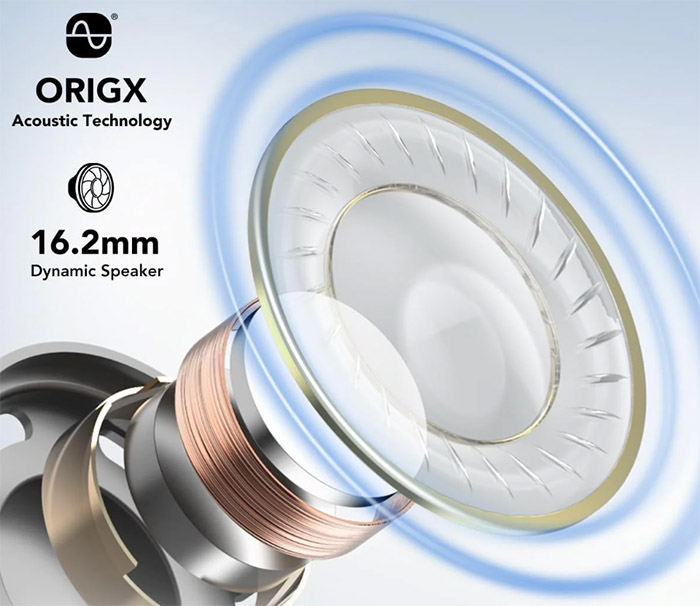
Also, be aware that you will be able to hear everything around you since your ears are not sealed at all and this will have an impact on the sound quality, which is why technologies such as the OrigX need to work properly, otherwise the bass will be pretty much nonexistent. Now, the first set of tests checks some technical aspects of the headphones, such as driver quality and matching. The first test showed that the sweeping sound was clear and I could hear no buzzing, which is excellent. As for the matching test, it seems that the tone was played exactly in the middle of my head (no deviation).
Next, I played a binaural recording to get a better idea about what to expect from the TOZO OpenReal. The volume had to be set to 90% since it was a bit too low, but the imaging seems to be well done. I could tell with precision where each singer was and which instrument was played, so there was good differentiation between them. The sound stage is not that wide though and a few details which I could hear with monitor headphones were lost. But, the song was colorful and not at all fatiguing, so the TOZO OpenReal seem fun to listen to music. And that takes us to the set of tracks that I usually play when testing headphones – it’s worth mentioning that I am using Amazon Music which is the highest streaming quality that’s available right now (as far as I know).

That being said, the first song was the low-bass-focused ‘Zhu – Faded’ and, while the volume was set to 80% volume, I could hear that the voice was crystal clear, the bass is there and to be honest, it’s more present that I expected it to be considering there is no sealing around the ear. Even so, it is still not very potent and to get an idea about how full it can get, just cover the ear with your hand (the bass will come alive). Next, I played ‘Donald Fagen – Morph the cat’ which is focused more towards the mid-bass. The instrument differentiation is very well done (each has its place and doesn’t bleed into the other) and the voice is very clear.
You can hear the mid-bass, but again, it lacks that potency – I suppose it’s somewhat close to monitor headphones performance in this regard. The next bass-focused song was ‘System of a Down – Mr Jack’ and this is difficult track to reproduce since it’s very easy to get a muddy sound due to so many instruments overlapping and the voices don’t help either. The voices are again very clear and perhaps a slightly bit forwarded, but some sound clarity is lost when all instruments play at the same time (some muddiness is definitely present). Afterwards, I listened to ‘Vance – She Burns’ and the voice is clear and well reproduced
It does seem that the mids are these headphone’s strength, the sound is clear and even if the bass doesn’t have that much of a presence, the song sounds colorful and vibrant – also not all details are present (I know this song very well). Afterwards, I listened to ‘Ariana Grande – Breathin’ and it sounds like the female voice is a bit more forwarded than the male voice, so the instruments seem to take a second place. Lastly, I listened to the treble-focused ‘Guns n Roses – Sweet Child o Mine’ and yes, it’s a tiny bit bright, which means that it may induce fatigue at some point, but it’s not immediately overwhelming.
The Mobile App
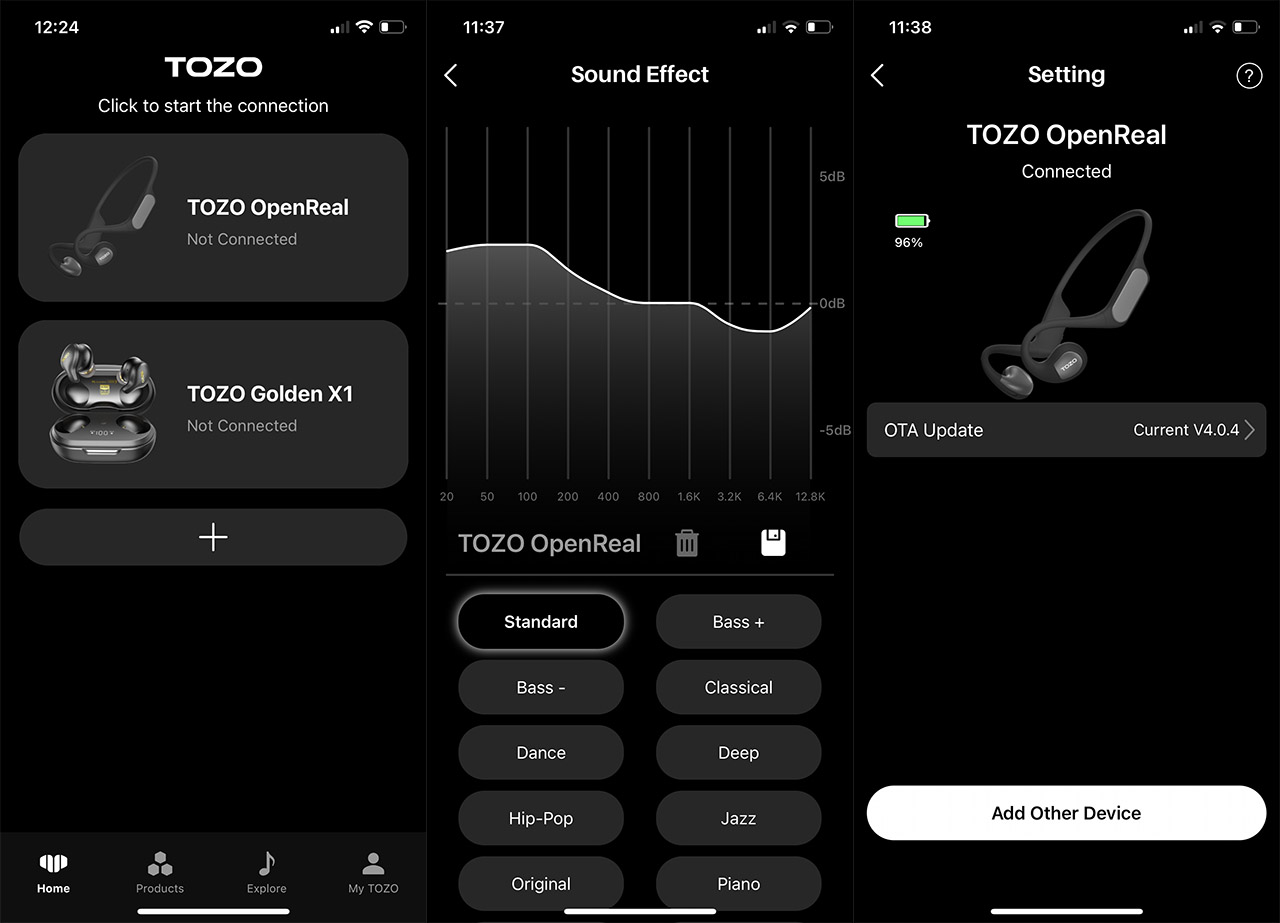
I am not a stranger to the TOZO app since I have used it when I tested the TOZO Golden X1 TWS earbuds and the pairing process is pretty much the same: make sure that Bluetooth is enabled and the app should see the headphones immediately. That’s it, you should now be able to roam the dedicated settings. Well, there isn’t a lot that can be customized, but it is possible to use what’s the most important, the EQ. Indeed, there are a few presets to choose from, but it is entirely possible to adjust the way the headphones will sound as well. And yes, you can save the new profiles. Additionally, it is possible to update the firmware and see the exact remaining battery life – something that’s not possible on the TOZO OpenReal themselves. And that’s about it.
The Call Quality
Although it’s not always wise to judge a microphone performance by its size, the two ENC mic on the TOZO OpenReal did remind me of the Sony WH-1000XM3, so I expected a good performance. And it’s really not bad, even if not really on par with the Sony’s (price-wise, it makes sense).
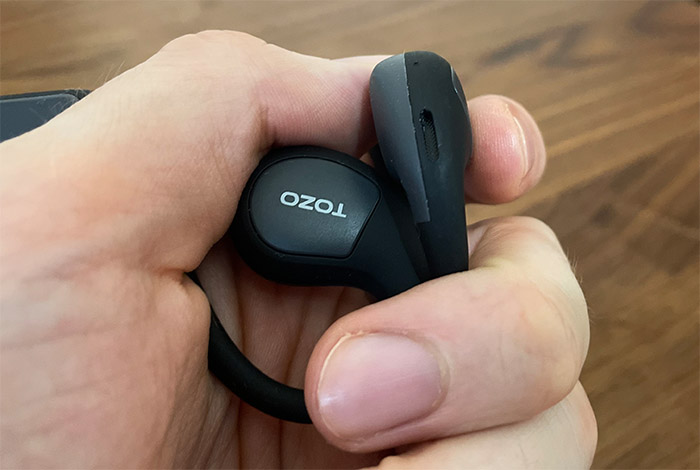
I could hear the other person clearly even if I was in a more noisy environment (I did have to raise the volume all the way up). But what’s interesting is that even if I was in this loud coffee shop, the caller could still hear my voice decently well, so the ambient noise canceling algorithm work fine. But, even if it was quiet, there was still a faint echo-y effect when I spoke – it’s still better than most other headphones in the same price range.
The Battery Life
As you saw in the previous sections, I listened to music at a higher volume, about 80% and I know that the manufacturer has advertised that the TOZO OpenReal could reach up to 16 hours with the volume set to 50%. But in my case, I lost about 6% every half an hour, so in total, I got about eight hours and a half before I had to recharge the headphones. And it’s not a bad performance considering that the air conduction tech pretty much requires a higher volume to listen to music while you’re cycling or jogging near a busy street.
The Conclusion
The directional speakers on the TOZO OpenReal work really well and they’re definitely a good alternative to the TWS earbuds in case your ear canals get easily irritated by prolonged use. Surely, there is some sound bleed, but that’s to be expected when there is no ear sealing. The bass is a lacking and I know that the OrigX does work hard at simulating booming bass, but it still remains probably the main weakness of the TOZO OpenReal (and other air conduction headphones in general). So, if you need a pair of headphones that will stick to your ears when working out outdoors and find the TWS earbuds annoying, then definitely check out the TOZO OpenReal headphones.
TOZO OpenReal
-Pros
- The headphones are comfortable
- The sound quality is good (considering that we're dealing with air conduction technology)
- The sound is clear
- Good call quality
- Fairly long battery life
Cons
- Can't see the remaining battery life.
- Proprietary charging cable (using magnetic pins)
- The controls can be a bit confusing

Mark is a graduate in Computer Science, having gathered valuable experience over the years working in IT as a programmer. Mark is also the main tech writer for MBReviews.com, covering not only his passion, the networking devices, but also other cool electronic gadgets that you may find useful for your every day life.

